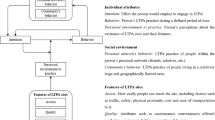Abstract
Engaging in a regular physical activity appears to be an important factor in the prevention of childhood obesity, which became one of the major public health challenges worldwide. The literature suggests that the relationship between physical activity and obesity is complex with many intervening factors that come from different aspects of the child’s life. Yet, so far, the proposed models do not include all of the identified factors. The main objective of this study is to simulate the child’s behavior within his/her social and physical environments in order to understand precisely the relationship between the PA and childhood obesity. This paper proposes a simulation model using the multi-agent paradigm.
Access this chapter
Tax calculation will be finalised at checkout
Purchases are for personal use only
Preview
Unable to display preview. Download preview PDF.
Similar content being viewed by others
References
Mittal, S.: Emergence in stigmergic and complex adaptive systems: A formal discrete event systems perspective. Cogn. Syst. Res. 21, 22–39 (2013)
Chen, D., Wang, L., Chen, J.: Large-Scale Simulation: Models, Algorithms, and Applications. Taylor & Francis (2012)
Rychetnik, L.: Criteria for evaluating evidence on public health interventions. J. Epidemiol. Community Heal. 56, 119–127 (2002)
Aziza, R., Zgaya, H., Guinhouya, B., Borgi, A.: Proposal for an agent-based knowledge model for the study of the relationship between physical activity and childhood obesity. In: Francophone Conference - Management and Engineering of Hospital Systems GISEH., Quebec (2012)
Organization, W.H.: Obesity: Preventing and Managing the Global Epidemic. World Health Organization (2000)
Guinhouya, B.C.: Physical activity during the development of the child. Medecine Sciences Publications, Paris (2012)
Vorwerg, Y., Petroff, D., Kiess, W., Blüher, S.: Physical activity in 3-6 year old children measured by SenseWear Pro®: direct accelerometry in the course of the week and relation to weight status, media consumption, and socioeconomic factors. PLoS One 8, e60619 (2013)
Tappe, K.A., Glanz, K., Sallis, J.F., Zhou, C., Saelens, B.E.: Children’s physical activity and parents’ perception of the neighborhood environment: neighborhood impact on kids study. Int. J. Behav. Nutr. Phys. Act. 10, 39 (2013)
Ejima, K., Aihara, K., Nishiura, H.: Modeling the obesity epidemic: social contagion and its implications for control. Theor. Biol. Med. Model. 10, 17 (2013)
Dangerfield, B., Abidin, N.Z.: Towards a model-based Tool for Evaluating Population-level Interventions against Childhood Obesity. In: 21st International Conference of the System Dynamics Society, Seoul, Korea (2010)
Giabbanelli, P.J., Alimadad, A., Dabbaghian, V., Finegood, D.T.: Modeling the influence of social networks and environment on energy balance and obesity. J. Comput. Sci. 3, 17–27 (2012)
Prachai, S.: The Design of Diabetes Simulation System using Multi-Agent. Procedia - Soc. Behav. Sci. 40, 146–151 (2012)
Yang, Y., Diez Roux, A.V., Auchincloss, A.H., Rodriguez, D.A., Brown, D.G.: A spatial agent-based model for the simulation of adults’ daily walking within a city. Am. J. Prev. Med. 40, 353–361 (2011)
Guinhouya, B.C., Apété, G.K., Hubert, H.: The determinants of habitual physical activity in children: update and implications for care and prevention options in pediatric overweight/obesity. Rev. Epidemiol. Sante Publique. 58, 49–58 (2010)
Nicolet, J.L.: Risks and complexity. Harmattan Editions (2010)
Kari, J.: Theory of cellular automata: A survey. Theor. Comput. Sci. 334, 3–33 (2005)
Bonabeau, E.: Agent-based modeling: methods and techniques for simulating human systems. Proc. Natl. Acad. Sci. USA 99, 7280–7287 (2002)
Qu, Z., Garfinkel, A., Weiss, J.N., Nivala, M.: Multi-scale modeling in biology: how to bridge the gaps between scales? Prog. Biophys. Mol. Biol. 107, 21–31 (2011)
Müller, J.P.: From autonomous systems to multi-agent systems: Interaction, emergence and complex systems (2002)
Zadeh, L.A.: Fuzzy sets. Inf. Control. 8, 338–353 (1965)
Author information
Authors and Affiliations
Corresponding author
Editor information
Editors and Affiliations
Rights and permissions
Copyright information
© 2014 Springer International Publishing Switzerland
About this paper
Cite this paper
Aziza, R., Borgi, A., Zgaya, H., Guinhouya, B. (2014). A Multi-agent Simulation: The Case of Physical Activity and Childhood Obesity. In: Omatu, S., Bersini, H., Corchado, J., Rodríguez, S., Pawlewski, P., Bucciarelli, E. (eds) Distributed Computing and Artificial Intelligence, 11th International Conference. Advances in Intelligent Systems and Computing, vol 290. Springer, Cham. https://doi.org/10.1007/978-3-319-07593-8_42
Download citation
DOI: https://doi.org/10.1007/978-3-319-07593-8_42
Publisher Name: Springer, Cham
Print ISBN: 978-3-319-07592-1
Online ISBN: 978-3-319-07593-8
eBook Packages: EngineeringEngineering (R0)




